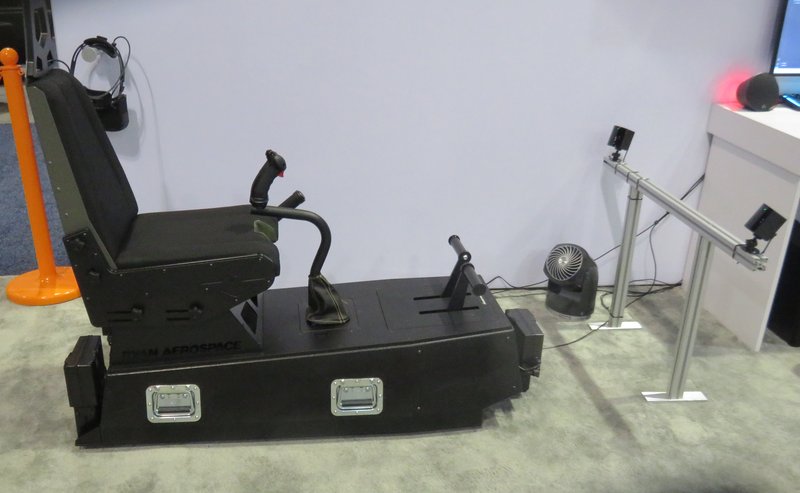Express delivery – are rapid-development COTS-based simulators finally ready to roll?
The use of COTS equipment and open standards for integration and interoperability has long been lauded as a route to reducing cost and development time for simulation systems. But reality has not always matched up to expectation.
However, customer demands, improved capabilities and the application of common sense has meant that integrated COTS (commercial off the shelf) systems are equally likely to be offered as solutions, and in their most basic form can be assembled in fairly short order... Continues below
Newsletter Sponsor:

Above: VBS4 software is already widely used by many simulation system developers, so lends itself to rapid integration into bespoke COTS-based devices. (Image: BISim)
This was illustrated vividly at this year’s I/ITSEC event in November, when BAE Systems showcased a door gunner trainer that had been assembled using a selection of COTS components in less than 30 days.
Don Widener, chief technology officer for BAE Systems Intelligence Solutions, told the author that ‘we wanted to show how COTS products could be used to create an end-to-end interoperable system for the LVC (live, virtual constructive) environment’.
The aim, he added, was to produce a realistic ‘kinesynthetic experience, including feel, sound, touch and even wind – there’s a fan as well’.

Providing mission-critical training and equipment, this elevated level of innovation can only be provided by the best in the industry. Visit FlightSafety.com.
The concept demonstrator consisted of a door-mounted machine gun on a motion platform linked to a pilot station. The gunner station consisted of a surrogate M240 machine gun provided by Laser Shot, mounted on a simple platform which Widener said had been constructed in under 24 hours.
The platform had an optional motion capability with six-inch throw actuators from D-BOX Technologies, but these were not fitted for the demonstration.
The gunner was equipped with a Varjo mixed reality (MR) head-mounted display (HMD) which displays a virtual environment but using pass-through technology allows the wearer to see and handle real or emulated equipment within a certain distance limit, in this case the machine gun.
The gunner’s station was also provided with a Pitch Talk simulated communications system from Pitch Technologies.
Other articles in this newsletter:
Chemistry, not physics? How to train for data-centric warfare
Second chances? What’s on the table as Improbable Defence’s UK arm is reborn as Skyral
Individual head movements of both gunner and pilot, together with the movement of the machine gun, were logged using Vive tracking technology. Widener noted that a special vibration dampener for the tracker on the gun was fabricated for the system, again within a 30-day timespan.
The basic pilot station, with one-inch actuators, was supplied by Australian company Ryan Aerospace from its HELIMOD range, with the pilot also equipped with a Varjo headset and Pitch Talk comms.

Above: The pilot station for the BAE Systems door gunner simulator displayed at I/ITSEC was supplied off the shelf from Ryan Aerospace’s HELIMOD product line. (Photo: author)
The virtual environment and simulation were provided by Bohemia Interactive Simulations (BISim) using Virtual Battle Space 4 (VBS4) with its whole-earth terrain database. The whole system was run using Pitch Commander software.
Widener said that alongside these COTS products the integration was achieved using the High Level Architecture 4 open interoperability standard for distributed simulation. The device was also integrated into BISim’s VBS4 demonstration being conducted on the adjacent stand at I/ITSEC.
Widener acknowledged that the concept demonstrator was not exactly starting from scratch though. Laser Shot weapons are routinely used with VBS, so integration of weapon effects was not new.
It should also be noted that both BISim and Pitch are wholly owned subsidiaries of BAE Systems, so their capabilities were well known to the project team. ‘Some previous integration had been proven,’ Widener said, ‘so we knew some of the things would work.’
He added that the integration of different COTS products, albeit at a far more complex level, was also the philosophy behind Project OdySSEy, a BAE Systems privately funded venture to create a single synthetic environment to support multi-domain training. In this case the core architecture and the integration capability have been developed by BAE.
Despite these caveats, this was an interesting demonstration of the future possibilities of assembling COTS products using open standards. Elements of the demonstrator were in evidence elsewhere in the exhibition, notably the Varjo MR HMD which has been swiftly adopted by several manufacturers and integrated into their simulation systems.
And of course VBS is already ubiquitous amongst western military simulations, providing a virtual training environment, although even BISim is working to create a ‘headless’ visualisation-agnostic version of its simulation specifically to allow customers to select their own system from different COTS offerings.
Increasingly, defence manufacturers are turning to visualisation systems developed by the gaming industry in order to benefit from the huge sums invested there.
Indeed, it was noticeable how many manufacturers have entered partnerships with game companies to achieve this. Epic Games, which produces the Unreal Engine, is a notable example – Thales, SimCentric and Lockheed Martin have all entered into relationships with Epic in order to use Unreal.
In the modern environment where commercial open standards and architectures are the norm, the concrete result of the BAE project perhaps should not be surprising. But the speed with which it was achieved was certainly a significant achievement and is perhaps an indicator of how much simpler this type of integration could be in future.
Don't want to miss out on future Decisive Edge content? Make sure you are signed up to our email newsletters.











